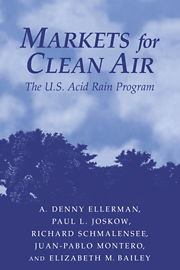Book contents
- Frontmatter
- Contents
- List of Illustrations
- List of Tables
- Preface
- Acknowledgments
- Part I Background
- Part II Compliance and Trading
- 5 Title IV Compliance and Emission Reductions, 1995–97
- 6 Emissions Trading: The Effect on Abatement Behavior
- 7 Emissions Trading: Development of the Allowance Market
- 8 Title IV's Voluntary Compliance Program
- 9 Cost of Compliance with Title IV in Phase I
- Part III Questions and Implications
- Appendix: Effect of Title IV on SO2 Emissions and Heat Input by Susanne M. Schennach
- Bibliography
- Index
7 - Emissions Trading: Development of the Allowance Market
Published online by Cambridge University Press: 10 December 2009
- Frontmatter
- Contents
- List of Illustrations
- List of Tables
- Preface
- Acknowledgments
- Part I Background
- Part II Compliance and Trading
- 5 Title IV Compliance and Emission Reductions, 1995–97
- 6 Emissions Trading: The Effect on Abatement Behavior
- 7 Emissions Trading: Development of the Allowance Market
- 8 Title IV's Voluntary Compliance Program
- 9 Cost of Compliance with Title IV in Phase I
- Part III Questions and Implications
- Appendix: Effect of Title IV on SO2 Emissions and Heat Input by Susanne M. Schennach
- Bibliography
- Index
Summary
The argument for the cost-minimizing properties of emissions trading rests, of course, on the assumption that an external market for permits exists and that it is reasonably efficient. By “efficient” we mean that the prices for permits are transparent to buyers and sellers, transaction costs are low, arbitrage opportunities are quickly exploited, and buyers and sellers take full advantage of the opportunities to reduce compliance costs by engaging in trading activity. The limited experience with emissions trading prior to 1990 was not particularly encouraging in this regard (Hahn, 1989; Hahn and Hester, 1989), and there was considerable doubt whether the tradable permit feature of Title IV would meet with any greater success than did earlier programs involving emissions trading.
Unlike previous tradable permit programs, Title IV embraces emissions trading among utilities with remarkably few restrictions. First, allowances can be traded nationally. Second, no review or prior approval of trades is necessary. Third, the purchase and holding of allowances is not restricted to utilities for which these permits would become a necessary input for the coal- or oil-fired generation of electricity. All sources receiving allowance allocations as well as third parties, such as brokerage firms and individuals, are free to buy allowances from or sell them to any other party. Fourth, neither the frequency nor the mechanisms for trading allowances is limited. Finally, allowances that are good for use in one year may be saved and used in future years.
- Type
- Chapter
- Information
- Markets for Clean AirThe U.S. Acid Rain Program, pp. 167 - 196Publisher: Cambridge University PressPrint publication year: 2000

